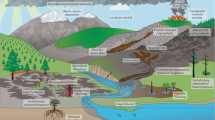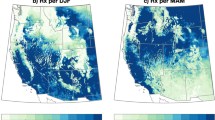Abstract
Record-breaking fire seasons are becoming increasingly common worldwide, and large wildfires are having extraordinary impacts on people and property, despite years of investments to support social–ecological resilience to wildfires. This has prompted new calls for land management and policy reforms as current land and fire management approaches have been unable to effectively respond to the rapid changes in climate and development patterns that strongly control fire behaviour and continue to exacerbate the risks and hazards to human communities. Promoting social–ecological resilience in rapidly changing, fire-susceptible landscapes requires adoption of multiple perspectives of resilience, extending beyond ‘basic resilience’ (or bouncing back to a similar state) to include ‘adaptive resilience’ and ‘transformative resilience’, which require substantial and explicit changes to social–ecological systems. Clarifying these different perspectives and identifying where they will be most effective helps prioritize efforts to better coexist with wildfire in an increasingly flammable world.
This is a preview of subscription content, access via your institution
Access options
Access Nature and 54 other Nature Portfolio journals
Get Nature+, our best-value online-access subscription
$29.99 / 30 days
cancel any time
Subscribe to this journal
Receive 12 digital issues and online access to articles
$119.00 per year
only $9.92 per issue
Buy this article
- Purchase on Springer Link
- Instant access to full article PDF
Prices may be subject to local taxes which are calculated during checkout

Lily Jane Clarke (a); Forest Service, USDA (b,d); Oregon Department of Forestry under a Creative Commons license CC BY 2.0 (c); Bureau of Land Management (e); US DOD, (f; the appearance of US Department of Defense visual information does not imply or constitute DOD endorsement); Ray Ford, Noozhawk.com (g); Craig D. Allen / USGS (h).
Similar content being viewed by others
References
Balch, J. K. et al. Switching on the big burn of 2017. Fire 1, 17 (2018).
The National Strategy (US Forest Service, 2014).
Schultz, C. A., Thompson, M. P. & McCaffrey, S. M. Forest Service fire management and the elusiveness of change. Fire Ecol. 15, 13 (2019).
Fischer, A. P. et al. Wildfire risk as a socioecological pathology. Front. Ecol. Environ. 14, 276–284 (2016).
North, M. P. et al. Reform forest fire management. Science 349, 1280–1281 (2015).
Schoennagel, T. et al. Adapt to more wildfire in western North American forests as climate changes. Proc. Natl Acad. Sci. USA 114, 4582–4590 (2017).
Dodge, M. Forest fuel accumulation—a growing problem. Science 177, 139–142 (1972).
McDonald, T., Gann, G. D., Jonson, J. & Dixon, K. W. International Standards for the Practice of Ecological Restoration – Including Principles and Key Concepts (Society for Ecological Restoration, 2016).
Abatzoglou, J. T. & Williams, A. P. Impact of anthropogenic climate change on wildfire across western US forests. Proc. Natl Acad. Sci. USA 113, 11770–11775 (2016).
Radeloff, V. C. et al. Rapid growth of the US wildland-urban interface raises wildfire risk. Proc. Natl Acad. Sci. USA 115, 3314–3319 (2018).
Bowman, D. M. J. S. et al. Human exposure and sensitivity to globally extreme wildfire events. Nat. Ecol. Evol. 1, 0058 (2017).
Schoennagel, T., Veblen, T. T. & Romme, W. H. The interaction of fire, fuels, and climate across Rocky Mountain forests. BioScience 54, 661–676 (2004).
Smith, A. M. S. et al. The science of firescapes: achieving fire-resilient communities. BioScience 66, 130–146 (2016).
Smith, A. M. S., Kolden, C. A. & Bowman, D. M. J. S. Biomimicry can help humans to coexist sustainably with fire. Nat. Ecol. Evol. 2, 1827–1829 (2018).
Moritz, M. A. et al. Learning to coexist with wildfire. Nature 515, 58–66 (2014).
Calkin, D. E., Cohen, J. D., Finney, M. A. & Thompson, M. P. How risk management can prevent future wildfire disasters in the wildland-urban interface. Proc. Natl Acad. Sci. USA 111, 746–751 (2014).
Holling, C. S. Resilience and stability of ecological systems. Annu. Rev. Ecol. Evol. Syst. 4, 1–23 (1973).
Pelling, M. The Vulnerability of Cities: Natural Disasters and Social Resilience (Routledge, 2012).
Walker, B., Holling, C. S., Carpenter, S. R. & Kinzig, A. Resilience, adaptability and transformability in social–ecological systems. Ecol. Soc. 9, 5 (2004).
Olsson, L., Jerneck, A., Thoren, H., Persson, J. & O’Byrne, D. Why resilience is unappealing to social science: theoretical and empirical investigations of the scientific use of resilience. Sci. Adv. 1, e1400217 (2015).
Manyena, S. B. Disaster Resilience in Development and Humanitarian Interventions. PhD thesis, Northumbria Univ. (2009).
Kolden, C. What the Dutch can teach us about wildfires. The New York Times (16 November 2018); https://nyti.ms/2zmHyub
Ager, A. A. et al. Network analysis of wildfire transmission and implications for risk governance. PLOS ONE 12, e0172867 (2017).
Higuera, P. E. et al. Integrating subjective and objective dimensions of resilience in fire-prone landscapes. BioScience 69, 379–388 (2019).
Institute of Medicine Healthy, Resilient, and Sustainable Communities After Disasters: Strategies, Opportunities, and Planning for Recovery (The National Academies Press, 2015); https://doi.org/10.17226/18996
Keane, R. E., Hessburg, P. F., Landres, P. B. & Swanson, F. J. The use of historical range and variability (HRV) in landscape management. Ecol. Manag. 258, 1025–1037 (2009).
Schoennagel, T., Nelson, C. R., Theobald, D. M., Carnwath, G. C. & Chapman, T. B. Implementation of National Fire Plan treatments near the wildland-urban interface in the western United States. Proc. Natl Acad. Sci. USA 106, 10706–10711 (2009).
Harvey, B. J., Donato, D. C. & Turner, M. G. High and dry: post-fire tree seedling establishment in subalpine forests decreases with post-fire drought and large stand-replacing burn patches. Glob. Ecol. Biogeogr. 25, 655–669 (2016).
Paveglio, T. B., Carroll, M. S., Stasiewicz, A. M., Williams, D. R. & Becker, D. R. Incorporating social diversity into wildfire management: proposing “pathways” for fire adaptation. For. Sci. 64, 515–532 (2018).
Davis, K. T. et al. Wildfires and climate change push low-elevation forests across a critical climate threshold for tree regeneration. Proc. Natl Acad. Sci. USA 116, 6193–6198 (2019).
Stevens-Rumann, C. S. et al. Evidence for declining forest resilience to wildfires under climate change. Ecol. Lett. 21, 243–252 (2018).
Krawchuk, M. A. et al. Topographic and fire weather controls of fire refugia in forested ecosystems of northwestern North America. Ecosphere 7, e01632 (2016).
Robinson, N. M. et al. Refuges for fauna in fire-prone landscapes: their ecological function and importance. J. Appl. Ecol. 50, 1321–1329 (2013).
Meddens, A. J. H. et al. Fire refugia: what are they, and why do they matter for global change? BioScience 68, 944–954 (2018).
Liang, S., Hurteau, M. D. & Westerling, A. L. Large-scale restoration increases carbon stability under projected climate and wildfire regimes. Front. Ecol. Environ. 16, 207–212 (2018).
Hood, S. M., Baker, S. & Sala, A. Fortifying the forest: thinning and burning increase resistance to a bark beetle outbreak and promote forest resilience. Ecol. Appl. 26, 1984–2000 (2016).
Building a More Resilient Grid (Sunrun, 2019); https://www.sunrun.com/sites/default/files/wildfire-mitigation-sunrun.pdf
Barnett, K., Parks, S. A., Miller, C. & Naughton, H. T. Beyond fuel treatment effectiveness: characterizing interactions between fire and treatments in the US. Forests 7, 237 (2016).
Shindler, B. et al. Trust: A Planning Guide for Wildfire Agencies and Practitioners—An International Collaboration Drawing on Research and Management Experience in Australia, Canada, and the United States (Joint Fire Science Program, Oregon State University, 2014).
Martinson, E. J. & Omi, P. N. Fuel Treatments and Fire Severity: A Meta-analysis (USDA, 2013).
Lake, F. K. et al. Returning fire to the land: celebrating traditional knowledge and fire. J. For. 115, 343–353 (2017).
Ryan, K. C., Knapp, E. E. & Varner, J. M. Prescribed fire in North American forests and woodlands: history, current practice, and challenges. Front. Ecol. Environ. 11, 15–24 (2013).
Kulig, J. & Pujadas Botey, A. Facing a wildfire: what did we learn about individual and community resilience? Nat. Hazards 82, 1919–1929 (2016).
Wigtil, G. et al. Places where wildfire potential and social vulnerability coincide in the coterminous United States. Int. J. Wildland Fire 25, 896–908 (2016).
Stedman, R. C. Subjectivity and social-ecological systems: a rigidity trap (and sense of place as a way out). Sustain. Sci. 11, 891–901 (2016).
Frantzeskaki, N., van Steenbergen, F. & Stedman, R. C. Sense of place and experimentation in urban sustainability transitions: the Resilience Lab in Carnisse, Rotterdam, The Netherlands. Sustain. Sci. 13, 1045–1059 (2018).
Nauslar, J. N., Abatzoglou, T. J. & Marsh, T. P. The 2017 North Bay and Southern California fires: a case study. Fire 1, 18 (2018).
Howell, J. & Elliott, J. R. Damages done: the longitudinal impacts of natural hazards on wealth inequality in the United States. Soc. Probl. 66, 448–467 (2019).
Turner, M. G., Whitby, T. G., Tinker, D. B. & Romme, W. H. Twenty-four years after the Yellowstone fires: are postfire lodgepole pine stands converging in structure and function? Ecology 97, 1260–1273 (2016).
Hansen, W. D. & Turner, M. G. Origins of abrupt change? Postfire subalpine conifer regeneration declines nonlinearly with warming and drying. Ecol. Monogr. 89, e01340 (2019).
Turner, M. G., Braziunas, K. H., Hansen, W. D. & Harvey, B. J. Short-interval severe fire erodes the resilience of subalpine lodgepole pine forests. Proc. Natl Acad. Sci. USA 116, 11319–11328 (2019).
Mensing, S. A., Michaelsen, J. & Byrne, R. A 560-year record of Santa Ana fires reconstructed from charcoal deposited in the Santa Barbara Basin, California. Quat. Res. 51, 295–305 (1999).
Kolden, A. C. & Henson, C. A socio-ecological approach to mitigating wildfire vulnerability in the wildland urban interface: a case study from the 2017 Thomas fire. Fire 2, 9 (2019).
A Defensible Community? A Retrospective Study of Montecito Fire Protection District’s Wildland Fire Program during the 2017 Thomas Fire (GEO Elements, LLC, Montecito Fire Department, 2018) https://www.montecitofire.com/retrospect-report-draft-october-9-2018
Fowler, C. & Konopik, E. The history of fire in the southern United States. Hum. Ecol. Rev. 14, 165–176 (2007).
Kulig, J. C., Edge, D. S., Townshend, I., Lightfoot, N. & Reimer, W. Community resiliency: emerging theoretical insights. J. Community Psychol. 41, 758–775 (2013).
Kolden, C. A. We’re not doing enough prescribed fire to reduce wildfire risk in the western United States. Fire 2, 30 (2019).
Acknowledgements
This manuscript was the result of a workshop held at the University of Montana in May 2017, titled ‘Defining ecological and social resilience in fire-prone landscapes’, funded by the Joint Fire Science Program (JFSP) through award 16-3-01-24 to P.E.H., A.L.M., C.M., D.B.M. and E.C.M. Additional support came from the National Science Foundation, through awards BCS-1539820 and BCS-1832486 to D.B.M., DEB-1655121 to P.E.H., DEB-1719905 to Z.R. and DMS-1520873 to C.K. Z.R. was also supported by JFSP award 16-3-01-04.
Author information
Authors and Affiliations
Contributions
D.B.M., T.S., P.E.H., M.K., B.J.H., E.C.M., C.S., C.M. and A.L.M. developed the outline and conceptual framework; all authors contributed ideas, provided critical feedback and wrote the manuscript.
Corresponding author
Ethics declarations
Competing interests
The authors declare no competing interests.
Additional information
Publisher’s note: Springer Nature remains neutral with regard to jurisdictional claims in published maps and institutional affiliations.
Rights and permissions
About this article
Cite this article
McWethy, D.B., Schoennagel, T., Higuera, P.E. et al. Rethinking resilience to wildfire. Nat Sustain 2, 797–804 (2019). https://doi.org/10.1038/s41893-019-0353-8
Received:
Accepted:
Published:
Issue Date:
DOI: https://doi.org/10.1038/s41893-019-0353-8
This article is cited by
-
Guiding principles for transdisciplinary and transformative fire research
Fire Ecology (2024)
-
The geography of social vulnerability and wildfire occurrence (1984–2018) in the conterminous USA
Natural Hazards (2024)
-
Persistent, viable seedbank buffers serotinous bishop pine over a broad fire return interval
Fire Ecology (2023)
-
Somatic symptoms, psychological distress and trauma after disasters: lessons from the 2014 Hazelwood mine fire and 2019–20 Black Summer bushfires
BMC Public Health (2023)
-
High-resolution wildfire simulations reveal complexity of climate change impacts on projected burn probability for Southern California
Fire Ecology (2023)



